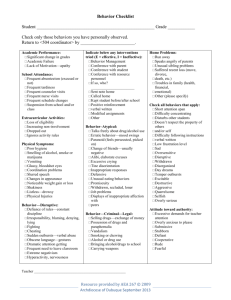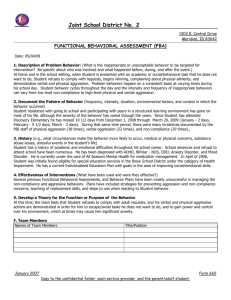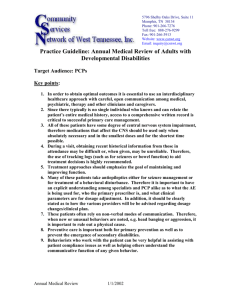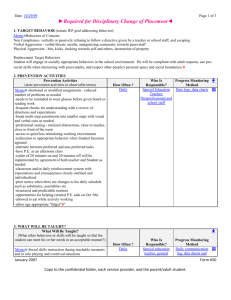digest - Human Kinetics
advertisement
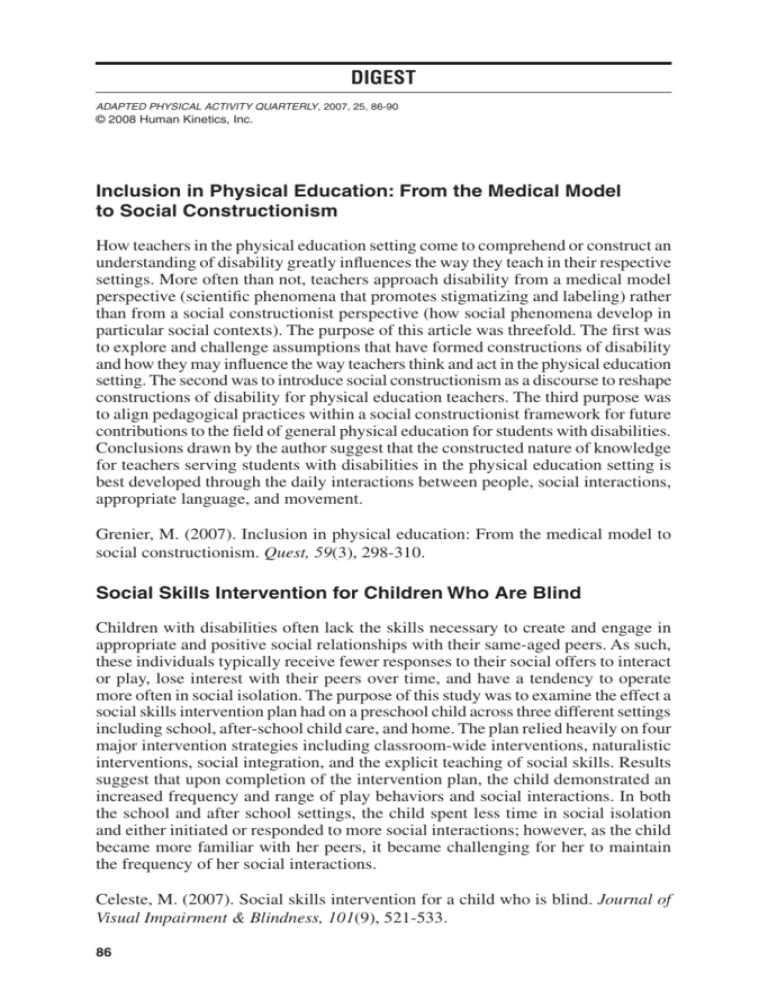
digest ADAPTED PHYSICAL ACTIVITY QUARTERLY, 2007, 25, 86-90 © 2008 Human Kinetics, Inc. Inclusion in Physical Education: From the Medical Model to Social Constructionism How teachers in the physical education setting come to comprehend or construct an understanding of disability greatly influences the way they teach in their respective settings. More often than not, teachers approach disability from a medical model perspective (scientific phenomena that promotes stigmatizing and labeling) rather than from a social constructionist perspective (how social phenomena develop in particular social contexts). The purpose of this article was threefold. The first was to explore and challenge assumptions that have formed constructions of disability and how they may influence the way teachers think and act in the physical education setting. The second was to introduce social constructionism as a discourse to reshape constructions of disability for physical education teachers. The third purpose was to align pedagogical practices within a social constructionist framework for future contributions to the field of general physical education for students with disabilities. Conclusions drawn by the author suggest that the constructed nature of knowledge for teachers serving students with disabilities in the physical education setting is best developed through the daily interactions between people, social interactions, appropriate language, and movement. Grenier, M. (2007). Inclusion in physical education: From the medical model to social constructionism. Quest, 59(3), 298-310. Social Skills Intervention for Children Who Are Blind Children with disabilities often lack the skills necessary to create and engage in appropriate and positive social relationships with their same-aged peers. As such, these individuals typically receive fewer responses to their social offers to interact or play, lose interest with their peers over time, and have a tendency to operate more often in social isolation. The purpose of this study was to examine the effect a social skills intervention plan had on a preschool child across three different settings including school, after-school child care, and home. The plan relied heavily on four major intervention strategies including classroom-wide interventions, naturalistic interventions, social integration, and the explicit teaching of social skills. Results suggest that upon completion of the intervention plan, the child demonstrated an increased frequency and range of play behaviors and social interactions. In both the school and after school settings, the child spent less time in social isolation and either initiated or responded to more social interactions; however, as the child became more familiar with her peers, it became challenging for her to maintain the frequency of her social interactions. Celeste, M. (2007). Social skills intervention for a child who is blind. Journal of Visual Impairment & Blindness, 101(9), 521-533. 86 Digest 87 Web-Based Training for Preparing Teachers to Supervise Paraeducators More than ever, the use of paraeducators to increase services provided in special education has become an important area of discussion. The effectiveness of paraprofessionals depends greatly on their preparation before entering the educational setting and their supervision within the setting. Currently, the training and supervision of these individuals is carried out largely by teachers. Unfortunately, teacher education programs tend to inadequately prepare teachers to assume this responsibility. To address this issue, an effort was made to develop and implement a web-based training model to assist teachers in effectively supervising paraeducators. The purpose of this paper was twofold: to identify the program features (content and delivery system, key instructional elements, and key management components) of the training model and to report initial feedback from six university sites that used this web-based training program. Results gathered from the feedback suggest that participants did increase their overall knowledge after completing the training program suggesting the effectiveness of the web-based model. Steckelberg, A., Vasa, S.F., Kemp, S., Arthaud, T.J., Asselin, S.B., Swain, K. & Fennick, E. (2007). A web-based training model for preparing teachers to supervise paraeducators. Teacher Education and Special Education, 30(1), 52-55. Teacher’s Verbal Aggression and Student’s Fair Play Behaviors The physical education setting has shown to be the most adequate environment to facilitate the sociomoral development of students (the promotion of social and moral development) as it pertains to their fair play behaviors. This same setting, however, contains factors that may also interfere with a student’s sociomoral development. Specifically, the effect verbal aggression by teachers has on students in the physical education setting greatly influences their sociomoral development, and thus their fair play behaviors. The purpose of this study was twofold: to investigate how physical education teacher’s verbal aggressiveness as perceived by the students is related to student’s fair play self-reported behaviors and to examine if students’ fair play behaviors are predicted by teachers’ verbal aggression. Results of the study suggest a strong relationship between teacher’s verbal aggression and student’s fair play behaviors as antisocial fair play behaviors positively correlated with teacher’s verbal aggression and prosocial fair play behaviors negatively correlated with teacher’s verbal aggression. Simply stated, if teachers wish to promote prosocial behaviors in their classes they must demonstrate verbal communication that is not aggressive. Mary, H., Alexandra, B., & Kimon, S. (2007, Spring). Physical education teacher’s verbal aggression and student’s fair play behaviors. Physical Educator, 64(2), 94-101. 88 Digest Building Helping Behaviors in Children With Autism Children with autism tend to exhibit severe and persistent deficits in social behavior. Often, these individuals lack the skills necessary to engage in appropriate and positive social relationships with both peers and adults alike. Children with autism typically have problems with cooperating, sharing, making friends, and helping others. As a consequence, they often operate in social isolation. The purpose of this study was to examine the emergence of helping responses in children with autism assisting adults using a multicomponent training procedure, or “teaching package.” Helping was chosen because it has been shown to result in longer social interactions than other classes of social behavior. The study examined the effect the treatment had upon the participant’s helping and nonhelping behavior responses across different trial types (training trials, probe trials, and nonhelping trials). Categories of helping included such things as locating objects, cleaning, putting away items, etc. Results suggest there were systematic increases in correct responding across the different trial types. Participants increased in their helping responses and became more adept at exuding the appropriate response to both helping and nonhelping situations. Reeve, S.A, Reeve, K.F., Buffington-Townsend, D., & Poulson, C.L. (2007). Establishing a generalized repertoire of helping behavior in children with autism. Journal of Applied Behavior Analysis, 40(1), 123-136. Inclusive High School Service Learning Programs Service learning programs are a common practice in education today but little is known about inclusive service learning programs. As such, the purpose of this study was to determine whether critical elements of high school service learning programs (HSSLPs) cited in the literature were perceived as important by stakeholders of inclusive HSSLPs. Focus groups were conducted at five nationally and/or regionally recognized inclusive HSSLPs, two of which had inclusive service learning programs embedded within physical education. Participants from the focus groups concurred with findings from the literature and confirmed the importance of each of the critical elements. They also expanded the description of the critical elements emphasizing the need for inclusive HSSLPs to be flexible and informal in addressing the elements. Finally, they recommended that HSSLPs (a) be linked to academic and life skills curricula, (b) eliminate barriers to including students with disabilities, (c) increase the inclusion of students with severe disabilities, (d) embrace an inclusive philosophy, and (e) engage in continuous program evaluation. This study may be of interest to professionals working with or developing inclusive service learning programs. Dymond, S. K., Renzaglia, A., & Chun, E. (2007). Elements of effective high school service learning programs that include students with and without disabilities. Remedial and Special Education, 28(4), 227-243. Digest 89 Social-Behavioral Learning Strategies for Children With Asperger Syndrome Individuals with Asperger Syndrome (AS) exhibit deficits in social interactions and, as such, educational programs for individuals with AS are often inclusive of social-behavioral learning strategies. This study replicated previous work using the Stop-Observe-Deliberate-Act (SODA; Bock, 2000) learning strategy with an individual with AS. The primary purpose was to expand on previous work by comparing the participant’s behaviors with that of a peer without a disability and by increasing the number of social settings in which observations took place. The SODA intervention involved the participant stopping, observing, and deliberating on a social situation using a self-talk questioning process. He/she then developed a specific list of things to do and/or say in the social setting prior to acting. A multiple-baseline-across-settings design was used to analyze the participant’s social behaviors without and with SODA in a cooperative learning setting, gameplaying situation, and during lunch. SODA was found to be effective in improving the social-behavioral problem solving of the participant with AS across all three settings and during both intervention and maintenance phases. Bock, M.A. (2007). A social-behavioral learning strategy intervention for a child with Asperger Syndrome. Remedial and Special Education, 28(5), 258-265. Balance Kinetics and Children With Cerebral Palsy Interested in the poor reactive balance control of children with cerebral palsy (CP), Chen and Woollacott performed a lower extremity joint torque analysis of static and dynamic balance after perturbation. Children with CP, between the ages of eight and 13, were compared to an age-matched group of peers and a non age-matched group of younger peers to determine if deficits in balance recovery are the result of pathology or developmental delays. The children with CP performed worse on all measures of balance recovery compared to both peer groups. This suggests that children with CP have a lower developmental level for recovery of postural control. Unlike the control groups, the children with CP did not demonstrate temporally organized activation of joint torques after perturbation. Instead, this group of children activated all joints simultaneously to recover from perturbation, suggesting that pathological symptoms of paresis or poor lower extremity motor coordination may also contribute to their inferior scores. The authors concluded their paper by discussing relevant research studies that suggest children with CP can improve their balance through training. Chen J & Woollacott M H. (2007). Lower extremity kinetics for balance control in children with cerebral palsy. Journal of Motor Behavior, 39, 4, 306 – 316. Redefining Adapted Physical Activity The author recognized that there has been limited research or commentaries on disability sport from people outside of the adapted physical activity (APA) 90 Digest field. Purposes of this article were to evaluate sport opportunities for people with disabilities and to provide suggestions to change sports policies, rules, and organizations to be more inclusive. The author writes about access and integration issues, concerns about classification, and the influences of families and media on the portrayal of sport. Finally, the author tries to instigate a discussion with people outside of APA on how to further develop the mindset that people with disabilities are athletes, not athletes with or despite their disabilities as is often portrayed in society. Thus, the author provides seven ideal-typical models that reshape sport to include people with disabilities and portray them as the athletes they are instead of “super-crips.” Nixon, H.L. (2007). Constructing diverse sports opportunities for people with disabilities. Journal of Sport and Social Issues, 31, 417-433. Children With Dyslexia and Their Gross Motor Behavior The primary purpose of this study was to compare the gross motor behavior of children with and without dyslexia. Both The Test of Gross Motor Development-2 and the Movement Assessment Battery for Children were administered to each group. A secondary aim of this study was to ascertain age differences within the dyslexic group on each of the two tests. More specifically, the ball skills, manipulative skills, and total balance subscales of the Movement Assessment Battery for Children were compared to the locomotor and object control subscales of the Test of Gross Motor Development-2. Results of the primary purpose indicated that the children with dyslexia performed significantly lower than the children without dyslexia on the total balance subtest. Results of the secondary purpose indicated that younger dyslexic children performed better than the older dyslexic children. The results suggest that cerebellar dysfunction may play a role in differences in performance for individuals with dyslexia. This paper would entice professionals with an interest in understanding gross motor proficiency in individuals with dyslexia. Getchell, N., Pabreja, P., Neeld, K., & Carrio, V. (2007). Comparing children with and without dyslexia on the Movement Assessment Battery for Children and the Test of Gross Motor Development. Perceptual and Motor Skills, 105, 763-772. Digest Edited by Rebecca Woodard Digest Compilers: Daniel W.S. Tindall, San Francisco State University Suzanna Rocco Dillon, Wayne State University Scott J. Pedersen, New Mexico State University Aaron Moffett, California State University, San Bernardino Kevin M. Casebolt, East Stroudsburg University, East Stroudsburg, PA

